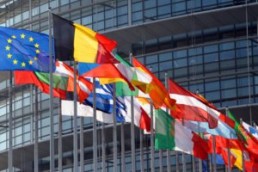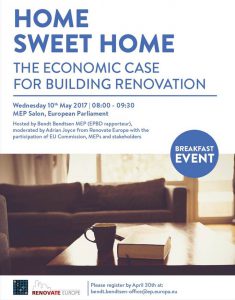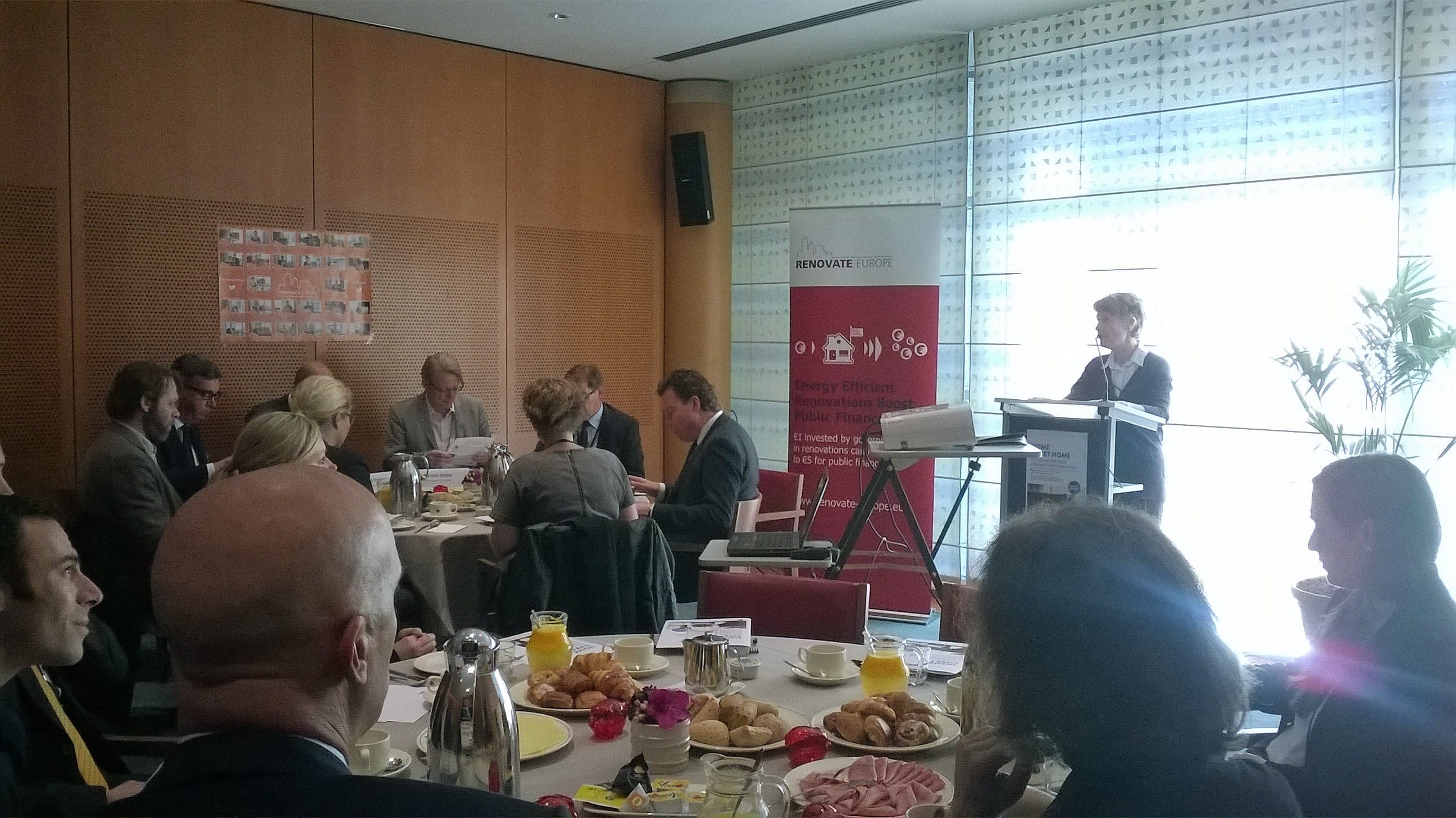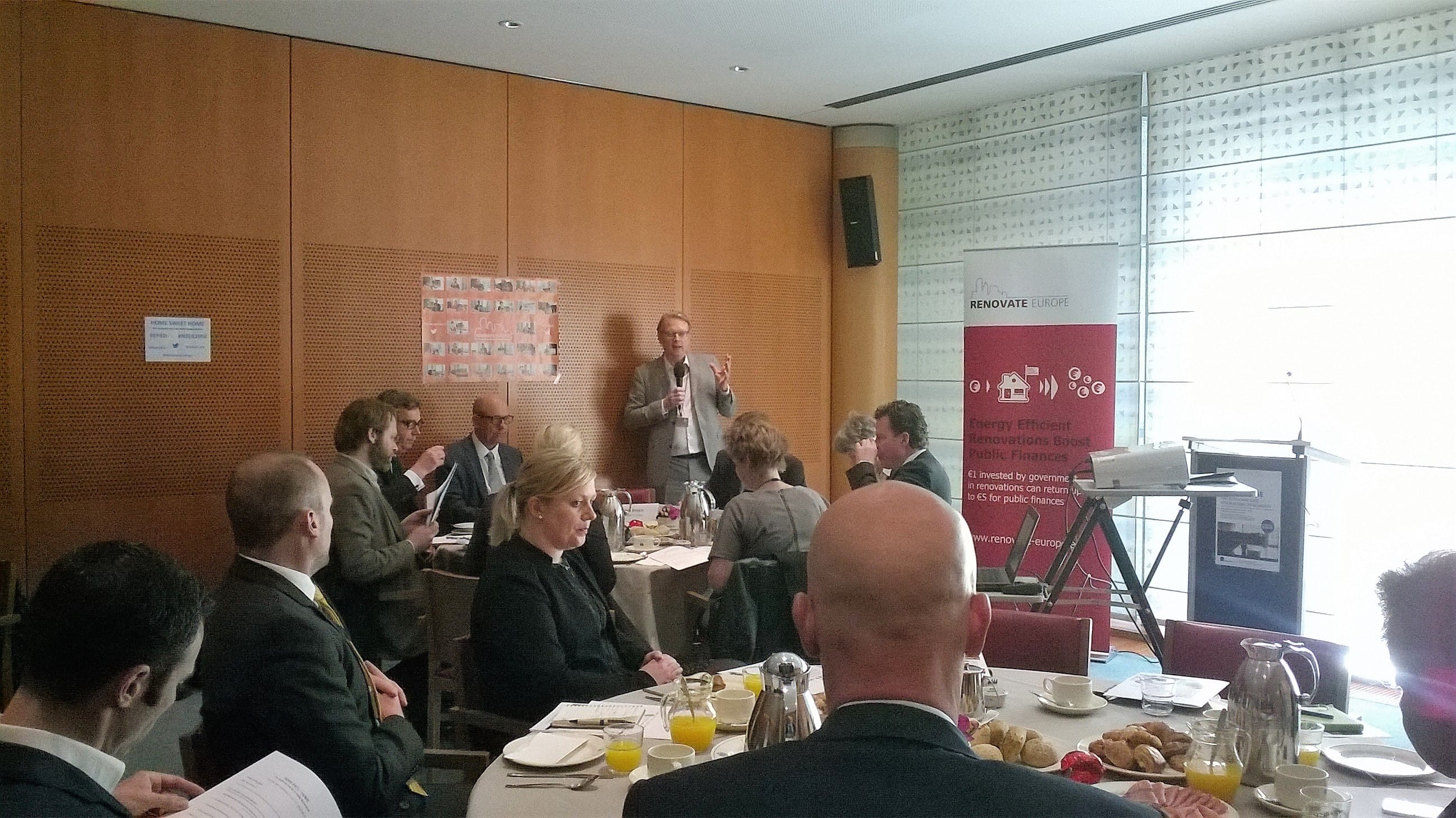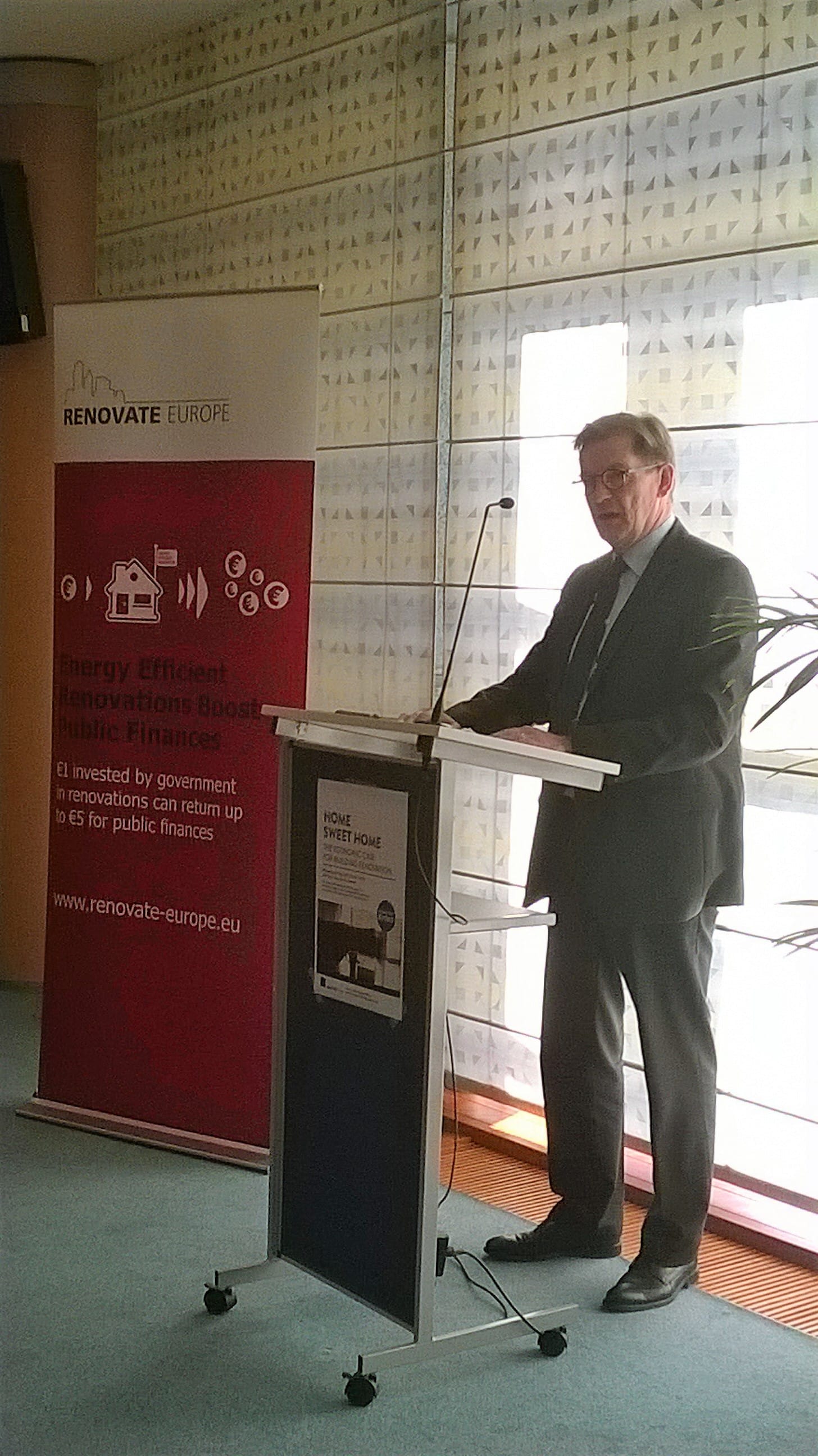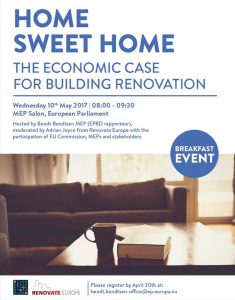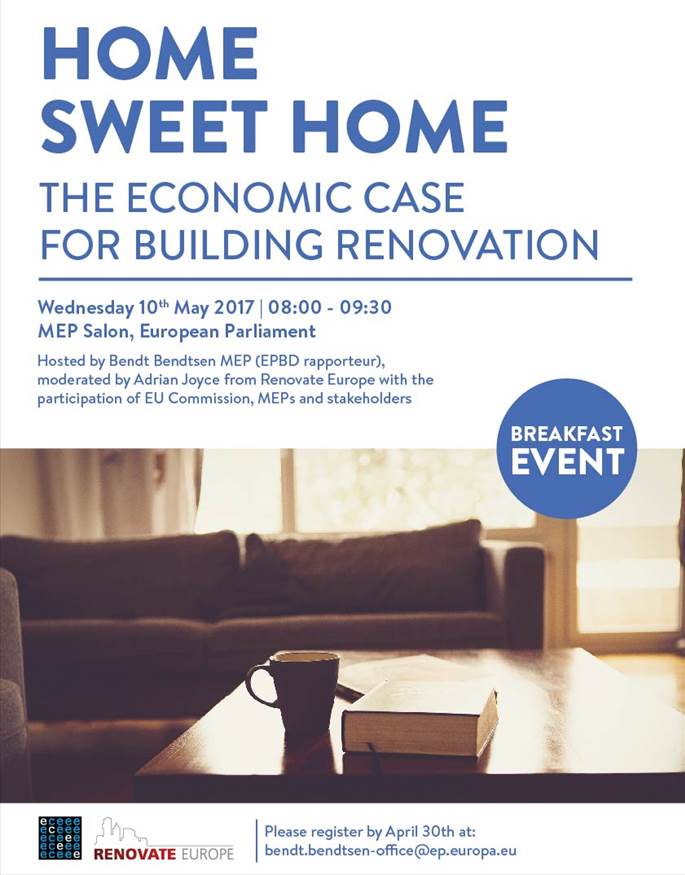Renovate Europe addresses Energy Ministers
Private financial resources are ready - but investors need a strong Renovation Plan from your Government!
Ahead of the Informal Energy Ministerial taking place on 18th and 19th May, Renovate Europe has addressed letters to the 28 Ministers asking them to respond to calls from European business and banks to increase confidence in the energy renovation market. How? By supporting a strong energy efficiency legislation that outlines a clear path to achieve a highly energy efficient NZEB building stock in the EU by 2050.
Read the letter that was sent to your Minister:
Briefing 2/2017: Energy Renovation – Making Financing Accessible to the People
10 May 2017
Here’s a riddle. Why is a product that can prevent energy poverty, dangerous global warming, indoor air pollution and energy import-dependence not the hottest ticket in town? Doubtless there are several factors – from the power of legacy energy lobbies to the sexiness of the brand – but the financing hurdles remain a key barrier to overcome. Simply put, upfront renovation costs are perceived as being too high to attract the people who need them most, and governments have proved reluctant to invest heavily in public programmes that could make a difference. But across Europe, a wide variety of innovative projects and schemes are now showing what could be a possible solution with a modicum of wit and imagination.

Download the Renovate Europe Briefing 2/2017: Energy Renovation – Making Financing Accessible to the People.
Read the Renovate Europe Oped Can we Finance a Renaissance in Energy Renovation?
Bank says “no shortage of funds for energy renovation”, but EPBD must address latent demand
JOINT PRESS RELEASE
Brussels, 10th May 2017
Bank says “no shortage of funds for energy renovation”, but EPBD must address latent demand
In a breakfast debate hosted by EPBD Rapporteur Bendt Bendtsen this morning in the European Parliament by eceee and Renovate Europe, MEPs, Commission officials and stakeholders joined the banking sector to discuss the economic case for building renovation and identified a lack of demand in the market that needs to be addressed.
“Banks are ready, willing and capable to meet the demand for energy renovation when it materializes. There is no shortage of funds - we have all the tools ready to be deployed! But confidence must be boosted in the market” explained Stephen Hibbert from ING bank speaking at the event. “Increased awareness and a stronger legislative and policy framework, with ambitious, bold and binding measures, can act as important triggers to stimulate consumer demand for energy renovation”, said Stephen.
MEP Bendt Bendtsen, Rapporteur on the EPBD, confirmed “Private investment is ready - be it the commercial banks like ING taking up the upfront investment, or be it institutional banking like pension funds securing the long-term income stream – both want to invest in energy renovation. A strong EPBD must support this private investment”.
The current revision of the Energy Performance of Buildings Directive (EPBD) offers a window of opportunity to address the demand for building renovation by boosting confidence and providing the regulatory certainty both for investors and for consumers.
Fiona Hall from eceee supported MEP Bendtsen’s call for a strong legislation that will help consumers satisfy their desire for a healthier, more comfortable home with lower energy bills. “Setting out a clear long-term vision for the building stock in the EPBD will boost consumer confidence and demand in a market eagerly waiting to lend a helping hand”.
MEP Miapetra Kumpula-Natri, S&D Shadow Rapporteur on the EPBD, reminded participants at the event about the importance for governments to also support financing initiatives targeted at helping the energy poor:“We must strive for a coherent package of legislation on energy renovation which will benefit all in society”.
The multiple benefits of energy renovation, for consumers, business and society at large, are widely accepted, but it is often wrongly assumed that there is no money available to fund building renovation.
“Contrary to popular belief, money is actually not the issue here”, explained Adrian Joyce from Renovate Europe. “As you heard, the banks are keen to invest, but they cannot address the latent demand. They need governments to support a stronger legislation which outlines a clear path to achieve a highly energy efficient NZEB building stock in the EU by 2050 in order to stimulate consumer awareness and demand in the market”.
END
#EPBD #NZEB2050 @RenovateEurope
More information about the event ‘Home Sweet Home’
Download the Press Release of the event
-------------------------------------------------------------------------------
Relevant documents:
Download the Draft Report on the EPBD drafted by MEP Bendt Bendtsen
Download the Renovate Europe Briefing “Energy Renovation – Making Financing Accessible to the People”:
Download the eceee 2-Pager: “How to Finance Energy Efficiency”
Briefing 2/2017: Energy Renovation - Making Financing Accessible to the People
Briefing 2/2017: Energy Renovation - Making Financing Accessible to the People
Here's a riddle. Why is a product that can prevent energy poverty, dangerous global warming, indoor air pollution and energy import-dependence not the hottest ticket in town? Doubtless there are several factors – from the power of legacy energy lobbies to the sexiness of the brand – but the financing hurdles remain a key barrier to overcome. Simply put, upfront renovation costs are perceived as being too high to attract the people who need them most, and governments have proved reluctant to invest heavily in public programmes that could make a difference. But across Europe, a wide variety of innovative projects and schemes are now showing what could be a possible solution with a modicum of wit and imagination.
Playing Europe's 'trump card'
Europe's single biggest source of funding for energy renovations is the EU, which has made €18bn available for energy efficiency improvements through 2014-2020, from the European Structural and Investment Fund. But a project is only as successful as its results. The European Commission has not provided figures on the uptake of monies thus far, but under the Barroso administration, EU States are thought to have allowed billions of euros earmarked for efficiency spending to go unclaimed.
A recent report by the EU's joint research center JRC urged the introduction of an EU renovation plan to transform, what it sees as a sectoral market failure, into one key pillar of “the renaissance of EU industry”. According to the JRC, such a plan could “de-risk” investments by using a cash pool made up of cohesion funds and existing national monies to finance refurbishments for the energy poor, in line with national renovation strategies. A shift from grants to preferential loans that blend public and private capital would help renovations become “the trump card for the new start for Europe,” the report said, spurring employment, economic growth, good health and decarbonisation.
The barriers facing the sector clearly require such a plan. Under today's tenancy laws, home renters in too many States, see little benefit in major cash outlays for improvements that will primarily benefit their landlords. A household's financial capacity to free up savings for renovations anyway depends on its income. Few poor home owners in the rural areas of countries with below-average per capita GDPs will be in a position to renovate their dwellings.
Finding the money for the EU's trump card is thus a core challenge, which may be partly addressed through 'on-bill financing' – the long-term repayment of energy renovation costs through energy bill savings. The Commission's “accessing clean energy in buildings”communication last winter launched a de-risking platform with a database of over 5,000 efficiency projects, and an initiative to explore under-writing the cost of renovations. This is welcome, as is the pledge of more up-to-date energy performance information for investors. But actions from banks and governments are also needed.
The colour of mortgages
Europe's banks have begun an expansion of their green mortgage portfolios, with one eye on the boost that energy renovations give to property prices and another on buy-to-renovate boom in the US housing market. The European Mortgage Federation, which represents Europe's major national banks, is working to increase the availability of green mortgages across Europe. Ambitious energy renovation decreases the chances of mortgage defaults by reducing the monthly energy cost while raising property values and allow banks to reflect the reduced risk with lower interest rates. There are several good examples.
Triodos Bank in the Netherlands winds down its interest rate on loans by 0.1% for every grade increase in a property's energy performance. Rabobank, also in the Netherlands, offers a 0.5% reduction in interest rates over a 10-year period for houses which are nearly zero emissions standard.
In Belgium too, ING began offering renovation loans of up to €50,000 this year, with a 1.95% interest rate over a period of up to a decade. Billboard advertising campaigns have helped to market the campaign, and ING aims to increase its green lending in real estate financing from 20% to 100% within five years. All real estate renovations it finances will have to be completed to a minimum 'C' grade energy class.
Other banks such as KBC Brussels have made moves in a similar direction, cutting energy renovation loan rates from 3.95% to 2.7%. Within the sector though, a lack of customer awareness and demand is still seen as an impediment to the greater proliferation of green mortgages, and this is an area where government intervention has the power to make a real difference.
Blueprints for green buildings
One bold programme in Estonia has seen the Kredex Fund offering State-backed housing loan guarantees from a €96m money pot. Grants can cover up to half the cost of energy audits or project design documents, and up to 35% of reconstruction costs depending on the ambition of the renovation. The balance of the money needed for the renovation project comes in the form of a preferential loan. The result? Between 2009 and 2013, nearly 100,000 Estonians benefitted from refurbishments, and more than 40,000 apartments were upgraded.
But the renovation movers and shakers are still concentrated in northwest Europe. A tax break offered by the Dutch government to support green investment has helped ensure the country is well represented in some of Europe's most forward-looking initiatives. The Netherlands has put up €400m to subsidise renovations in the rented sector, with low interest loans and grants often targeted at landlords and housing associations. One project, Energisprong, made international headlines with its blueprint for renovating 100,000 outdated low income homes using a mass-produced prefab insulated facade, augmented with solar panels, heat pumps, improved ventilation and new kitchens. The project is paid for by government-supported loans taken out against the expected energy savings over a 40-year period. Its groundbreaking finance model has inspired imitations across Europe, with Transition Zero putting out a tender for pilot projects in France, earlier this year.
Germany's KfW bank remains a best-practice model in European renovation financing, with an annual spend of €1.8bn. Home-owners who want to upgrade their properties can receive a subsidy covering 7.5-10% of costs, up to €5,000 per housing unit. Investment grants for KfW 'efficiency houses' can pay as much as a quarter of renovation costs with a maximum grant of €18,750 per housing unit. Generous repayment bonuses are also available.
In the Czech Republic, carbon market revenues have been ploughed into a Green Savings scheme to reduce buildings emissions. When the programme began in 2008, Kyoto-era carbon credits were used but the project is now funded by the EU's Emissions Trading Scheme. So far, around a billion euros have been invested through the scheme which utilises €75m of annual grants to leverage private sector investment. Most of the 5-7,000 beneficiaries each year have been single family households that are typically rural and middle-income earners, according to Chance for Buildings. “In Central and Eastern Europe it is definitely a model to follow,” says Petr Holub, Director at Chance for Buildings. ““Green Savings scheme is a successful programme but the Czech Republic still only has a 0.4% renovation rate and we need a five-fold increase in our absorption capacity to really contribute to energy savings on the national level.” Another €600m of funding from carbon market revenues is expected before 2021.
How to get houses fit for the 21st Century
Banks and project designers are taking good steps to address the renovations riddle but more are needed and the national renovation plans due from EU states this year offer a perfect opportunity. The path to phasing out or overhauling the worst-performing of Europe's housing stock could be smoothed by identifying 'trigger points' in a building's life where improvements can be made – such as changes of ownership or extension works. Targeted public spending and the increased use of cohesion and structural funds together with carbon market revenues could reduce risk perceptions and lower the cost of upfront investments. Awareness campaigns can then help to stimulate market demand, especially when combined with innovative financing models. Rome was not built in a day and Europe's housing stock will not be renovated overnight either. But better financing can help to put solid foundations in place for the overhaul we need to move our housing stock into the 21st century.
Download the Renovate Europe Briefing 2/2017: Energy Renovation - Making Financing Accessible to the People.
Read the Renovate Europe Oped Can we Finance a Renaissance in Energy Renovation?
Read the letter that was sent to the 28 Ministers ahead of the Informal Energy Ministerial on 18-19 May
Home Sweet Home - the Economic Case for Building Renovation
Wednesday 10th May 2017 - 8h00-9h30 - European Parliament
Breakfast Event - Hosted by Bendt Bendtsen MEP (EPBD rapporteur), Moderated by Adrian Joyce from Renovate Europe
Download the Event Overview and Programme
Download the Press Release of the event
Relevant documents:
Download the Draft Report on the EPBD drafted by MEP Bendt Bendtsen
Download the Renovate Europe Briefing “Energy Renovation - Making Financing Accessible to the People”
Download the eceee 2-Pager: “How to Finance Energy Efficiency”
The sky is the limit for Poland's air pollution crisis
28th April 2017, by Adrian Joyce, Renovate Europe Campaign Director

If a European police force dispatched scent-sensitive drones across the suburbs in a last ditch bid to prevent thousands of deaths, you might think a terror attack was imminent.
But the Polish police officers filmed last month surveilling residents in Zywiec were tailing a crime wave motivated by nothing more sinister than the desire to keep warm.
Its effects though are clear, or rather they are smoggy. For cheap wood, coal and waste burned indoors are contributing to a smog problem in the town that sometimes surpasses even Beijing's.
In Zakopane, Poland's top ski resort, fine dust concentrations are measured at densities greater than in New Delhi, creating lung-busting smogs, with all the attendant health hazards.
Across Poland, air pollution kills around 45,000 people every year, the legacy of a coal-dominated energy infrastructure and decades of poorly-built housing stretching back to the Soviet-era and beyond.
Seventy percent of the country's five million single-family households do not have adequate insulation, according to Poland's Institute of Environmental Economics.
This single-family demographic represents the poorer half of the population. To heat their buildings, many use the cheapest and least environmentally friendly materials and methods.
Substandard fuels such as brown coal and coal mine waste are incinerated en masse in obsolete solid fuel boilers with low efficiency and high emissions – not just of CO2, but particulate matter (PM2.5 and PM10) and carcinogenic substances such as benzo(a)pyrene.
An estimated 87% of Poland's benzo(a)pyrene emissions - and 52% of its PM10 releases – come from low stack emissions (sources with a height of less than 40m). Poland is currently facing a European court case over this issue.
In February, the development ministry promised to bring forward a programme for modernising Poland's single-family houses by the middle of the year.
This is welcome news, with the government due to hand in a national strategy for buildings renovations to the European commission this month.
Taken together, these two developments mark “a turning point,” says Anna Sokulska, a spokesperson for the Institute of Environmental Economics.
“They should be a part of a bigger and wider strategy,” she said, “but some people in government treat this only as something they are being forced to do by the EU. They don't treat it as something meaningful.”
This is a tragedy. Experience from the Czech Republic and Germany shows that a well-developed, ambitious program for buildings renovation can bring many new jobs, higher budgetary incomes, better health and a revival of the construction and insulation sectors.
Poland currently spends nothing on improving the energy efficiency of single-family buildings, compared to €1.50 in Germany, €2.50 in the Czech Republic and €5.50 in Slovakia.
It is time that Poland turned the page on antiquated polluting buildings that warm the planet but leave its own citizens huddling in cold and toxic misery. This is a problem that drones cannot solve on their own.
END
Learn more about Renovate Europe's National Partner in Poland and their work on Energy Renovation in Poland: Efficient Poland

